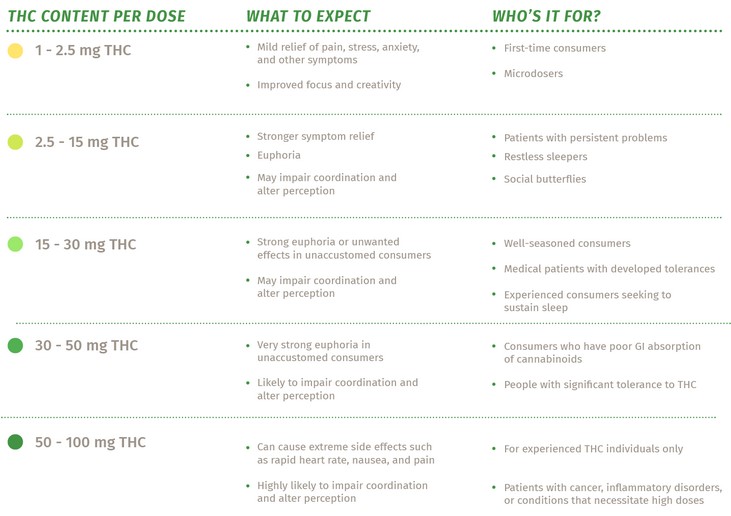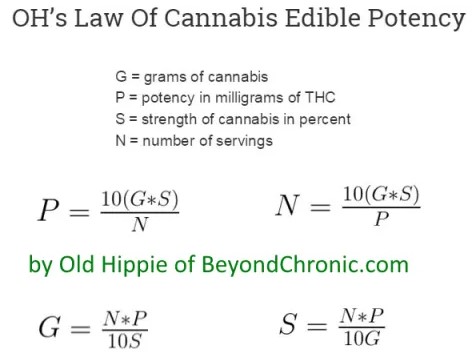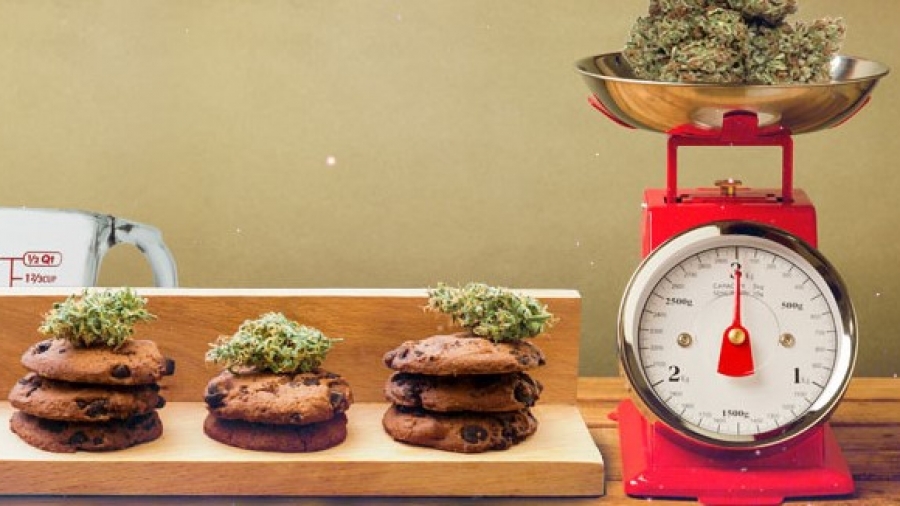Leafly turned March Madness into an excuse to determine the best cannabis-infused brownie of all time. Eight recipes were pitted against each other in our Pot Brownie Bracketology project, and ultimately a winner was crowned (seriously, you must make these brownies).
In our competition, each brownie recipe called for varying amounts of cannabutter, cannaoil, or in one case, ground, raw cannabis flower (bold move, Batali), so once the brownies were baked, we set out to calculate the potency of each batch. This, it turns out, is easier in theory than in practice.
Why Our Cannabutter Potency Calculations Were Wrong
Our initial thought process was this: first, determine the potency of the flower that will be used in creating the cannabutter or cannaoil. We used three different strains, each with a different level of THC, so we averaged the three to get an estimated average potency for all of the flower combined: in our case, 18.9%. That percentage represents the proportion of the cannabis’s dry weight that is THC, so we multiplied by our total cannabis dry weight and converted from grams to milligrams to get the the total amount of THC available to be extracted into the cannabutter.
Since we used six cups of butter, we divided this number by six to get (we thought) the average milligrams of THC per cup of cannabutter. Based on how much cannabutter was in each brownie recipe, we then divided this by the number of brownies each batch yielded to determine the final serving size – and knew there had to be a mistake. According to our calculations, each cup of our cannabutter should have had 2,646mg of THC, so a batch of brownies that called for one cup of cannabutter in the recipe and was cut into 12 pieces would theoretically have had over 220mg of THC per brownie. Our strongest batch should have clocked in at a whopping 400mg per brownie – 40 times the recommended recreational dose.
We immediately panicked – had we just made brownies with up to 40 times the recommended recreational dosage of THC? This seemed impossible given that our 1oz-to-1lb ratio of cannabis flower to butter is standard across several leading industry publications. So we got in touch with Dr. Kymron deCesare, chief research officer at comprehensive cannabis testing facility Steep Hill Labs, to figure out what was going on. We were very relieved to find that our calculations were inaccurate.
Example of Edible Potency Calculation
- I have 100g of top-shelf Sour Diesel. I know that top shelf is always approximately 20%, or 200mg THCA per 1g of flower. 200mg x 100 = 20,000mg THCA.
- The conversation from THCA to THC is 0.88. 20,000mg x 0.88 = 17,600mg maximum THC available to be extracted.
- Under ideal conditions, you get a 60% efficiency of extraction in dairy butter, so 17,600mg x 0.6 = 10,560mg maximum THC likely to be extracted.
- If my targeted dosage is 200mg per brownie, then 10,560mg / 200 = 53 brownies containing 200mg each. This is the maximum those brownies will have; they could have a whole lot less depending on cumulative errors.
Have you ever had a hard time estimating the potency of your homemade edibles? Share your story in the comments!
Next up: Learn how to store homemade edibles in Part 5 of our cannabis cooking series!
Of all the questions people ask me about cannabis cooking, dosing THC properly is one topic that always causes home cooks the most concern.
When I started writing about cooking with cannabis, I taught people how to estimate a reasonable THC dosage range to use in their cooking, just as cannabis cooks have been doing for thousands of years. Determining this “dosage window” involves balancing factors such as plant strength with the tolerance levels of the people consuming the food.
But instead of a reasonable dosage window with variations of 10 – 15 milligrams, wouldn’t it be great to know exactly how many milligrams of THC per serving your homemade edibles contain?
There’s a formula you can use to get a pretty close approximation, even when the plant matter you are using has not been lab-tested. Is this formula totally foolproof? No, because THC levels can vary widely, but it will give you a pretty good idea.
However, if you are cooking with cannabis that HAS been lab-tested, you can use this formula to calculate even more precisely just how many milligrams of THC—and even CBD—per serving your homemade edibles contain.
I’m going to explain the formula here, but don’t worry about doing the math because there’s a handy Marijuana Dosage Calculator tool that does all the work for you. You get access when you sign up for my free 10 minute online dosing class that will teach you how to use it anytime you cook with marijuana.

Determine THC Percentage
For the sake of argument, let’s say that you do not know how much THC is in the plant material you are using, since most people won’t. A U.S. government study in 2009 said the national average of THC is 10 percent, but we know that not all weed is created equal.
Reportedly, the government grown cannabis from the University of Mississippi that is supplied to researchers tops out at a measly 3 percent THC, whereas a 2015 Colorado study that analyzed 600 samples from that state saw some top shelf strains containing a whopping 30 percent THC.
If you are cooking with schwag—low quality brick weed, trim or with government weed—use a THC content closer to 3 percent to start your estimate. If you know that your plant material is more potent than schwag, you might want to start your estimate with 10 percent or slightly higher.
But since Uncle Sam says average marijuana contains 10 percent THC, that’s what we will use in our example.
It’s also a nice round number that makes it easier for people who are mathematically challenged to grasp the concept.

The Formula
Here’s how to do it:
1 gram of cannabis = 1000 milligrams
10% of 1000 milligrams is 100 milligrams
This means that, assuming we are using “average” marijuana, one gram of cannabis contains 100 milligrams of THC.
Next, let’s calculate how many milligrams are in a batch of marijuana butter.
As an example, let’s say I used one ounce (equaling 28 grams) of average quality marijuana to make one cup of butter. That would mean 2800 milligrams of THC went into that one cup of butter.
Moving on, the amount of THC in a given recipe will depend on the amount of butter used.
If I used 1/2 cup of that butter to make a batch of 36 cookies, then the entire batch would contain 1400 milligrams. Divide 1400 mg by the number of servings, in this case 36, to determine that each cookie will contain about 38.8 milligrams of THC.
To recap, first you need to estimate the percentage of THC in your plant material (or use the numbers from the lab test) and divide that into 1000 to get the per milligram amount.
Next, calculate the number of milligrams in your infusion and in the amount of infusion you will use to make your recipe. Divide that by the number of servings your recipe makes, and you will know the per serving dose.
You can use this formula to create recipes that always ensure you are delivering a THC dose that meets your needs.
If you find a given recipe delivers too strong of a dose, cut the amount of cannabutter or oil and dilute with regular butter or oil to make up the difference. Cookies not strong enough? Add more THC to your recipe with some decarboxylated kief, hash or hash oil.
I hope you grasp the dosage calculation concept. If not, don’t worry; click to the free dosing class for another example and access to the dosage calculator tool that will do all the work for you.
3 Step Dosing Formula (calculated in mg):
Step 1: Determining the total CBD your oil contains
If you have 1g of oil containing 85% CBD then:
Total Quantity = 1g (1000mg)
Total CBD = .85 * 1000mg = 850mg
Step 2: Determining the CBD dose for one batch (this is NOT how much oil to use)
| 15 | x | 5mg | = | 75mg* |
| Mould Cavities | Serving Dose | Batch CBD |
*75mg of CBD (NOT oil) is needed for one whole batch dose
Step 3: Determining how much oil to use
| 75mg | / | 850mg | = | 8.8% (.088) |
| Batch CBD | Total CBD | Percentage of your Total Quantity that should be used. |
| .088 | * | 1000mg | = | 88mg |
| Percentage of Total Quantity | Total Quantity | Recipe Quantity |
You would use 88mg of oil in your recipe to get 15 x 5mg candies.
Here is a simple formula for calculating the strength of your homemade edibles made using a single batch of cannabutter:
- How many grams of flower did you use to make your cannabutter? Multiply this by 1,000 – this converts it to milligrams (mg).
- What is the THC percentage of your flower? Multiply the weight of your flower in milligrams (from our last step!) by the percentage of THC in your flower.
- This is the estimated total milligrams in the whole batch. Divide this by the number of pieces you cut your batch into – now you know the dosage of your treat!
For Example: If we used 7g of flower with 12.5% THC:
- 7g x 1,000 = 7,000mg
- 7,000mg x .125 = 875mg
- Cut into 12 pieces: 875mg / 12 pieces = 72.91mg per piece!
Cut into 24 pieces: 875mg / 24 pieces = 36.46mg per piece!
Cut into 36 pieces: 875mg / 36 pieces = 24.31mg per piece!
Cut into 48 pieces: 875mg / 48 pieces = 18.23mg per piece!
Making edibles with distillate? While this can be tricky for some foods (such as gummies) it is an easy way to customize foods at home. To calculate your edibles dosage using distillate:
- How many mg of THC is in your distillate? Take the volume of distillate you used in mg (make sure this is in mg – not grams!) and multiply it by the THC percentage.
- Divide this by the number of pieces you cut your batch into – now you know the dosage of your treat!
For Example: If we used 500mg of distillate with 95% THC:
- 500mg x 0.95 = 475mg
- Cut into 12 pieces: 475mg / 12 pieces = 39.58mg per piece!
Cut into 24 pieces: 875mg / 24 pieces = 19.79mg per piece!
Cut into 36 pieces: 875mg / 36 pieces = 13.19mg per piece!
Cut into 48 pieces: 875mg / 48 pieces = 9.90mg per piece!
Now that you know your dose, how much should you eat?
We recommend starting out low and slow – try a low dose, and give it extra time to kick in before taking any more. A good rule of thumb for a new user is to try an edible with 5mg of THC, and wait 2-3 hours before taking any more. Take notes of how strong the high feels, and how quickly it kicks in. Even if you are an experienced edibles user, or have a high tolerance, it is still a good idea to start low and slow with the first bite of a new batch of edibles.

I realize there are a lot of experienced users on this page that might think a targeted dose of 200 mg per brownie is fine. But the article references the recommended recreational dose of 10 mg. Why are you using a targeted dose more than 20 times that in the potency extraction example? There seems to be quite a range in dosage out there. Anyone coming across this page for the first time or new users should be cautioned that a 200 mg brownie is far too potent for a casual user.